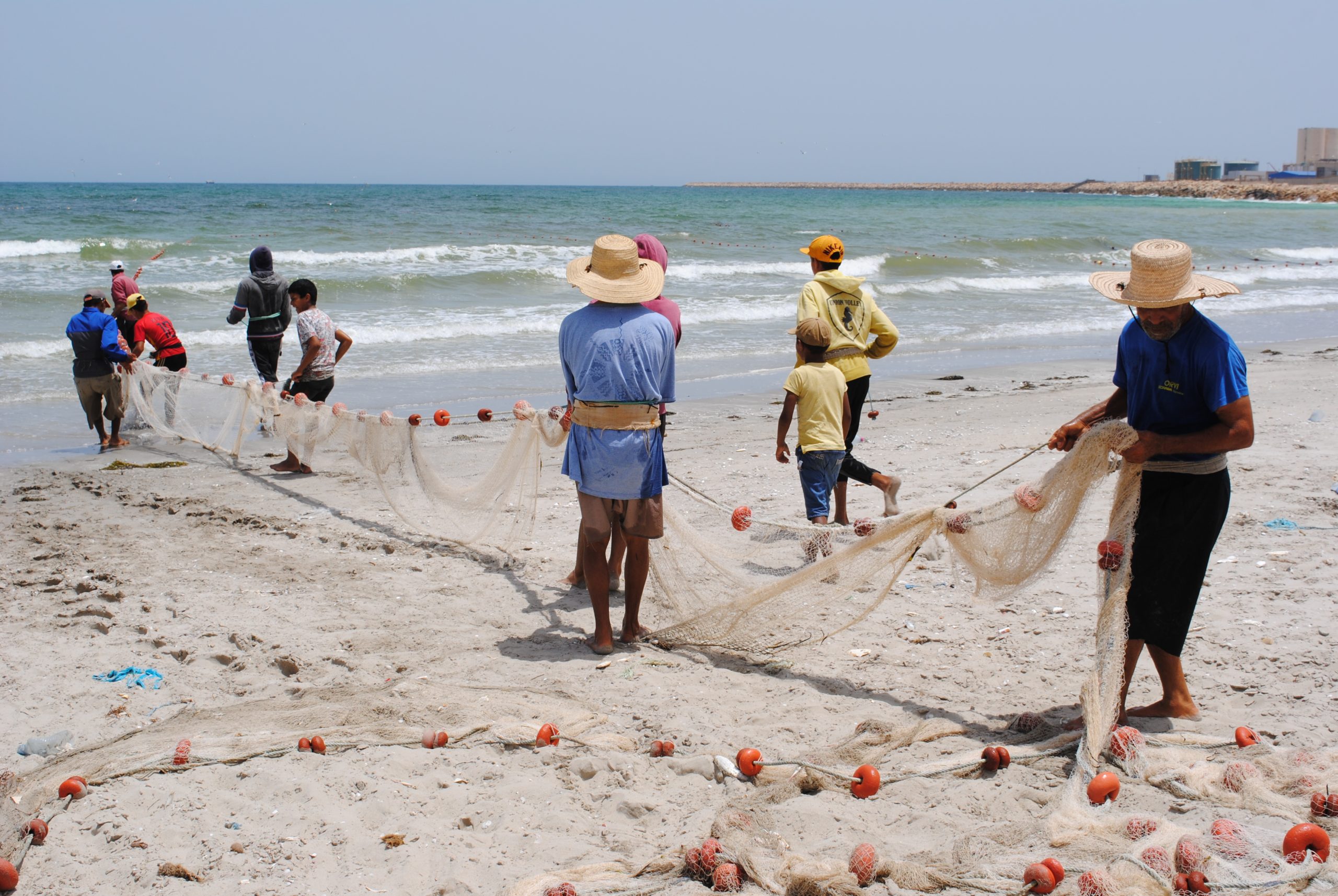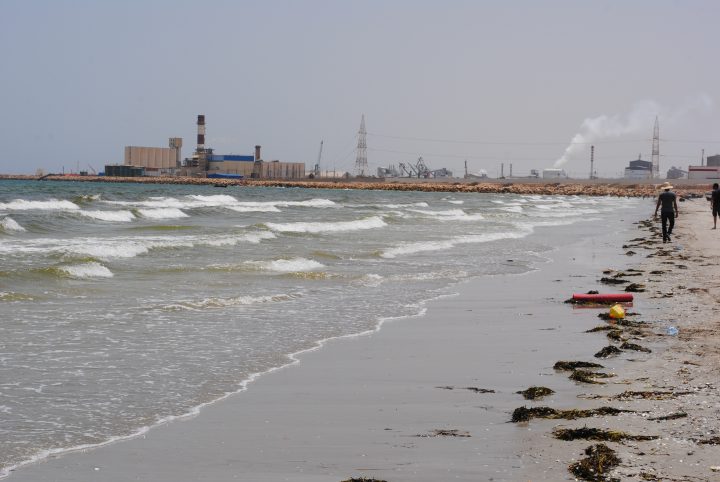The people want to breathe
In Tunisia’s coastal city of Gabès, residents live in the shadow of the phosphate industry. As pollution deepens and repression returns, a new generation revives the struggle for life itself.

Fishermen in Gabès, Tunisia. Behind them is the polluting industrial complex. Photo © Shreya Parikh, June 2021.
The bus from Tunis to the south passes small towns and green fields, many stretching toward the Mediterranean Sea, which remains invisible. As we enter Gabès, around 400km south of the capital, the color of the air suddenly shifts to yellow. The open windows bring in the putrid, sulfuric smell, and gradually, it becomes difficult to breathe.
During the many weeks I spent conducting fieldwork in Gabès during 2021 and 2022, the ghost of the “industrial complex”—a line of factories refining the phosphates mined in the country’s interior—was omnipresent. It appeared in stories families told about themselves, in the state’s promises of jobs that turned into systemic unemployment, in conversations about the now-lost paradise of Gabès’ oasis, where older women and men recalled their childhoods spent eating fresh fruit. The ghost lingered at dinner tables where everyone knew the cooked fish was polluted. And now, the ghost inhabits the bodies of Gabès’ residents in the form of persistent coughing and cancer.
On October 14, 2025, it was this ghost that entered a middle school in the Chatt Essalem neighborhood, forcing the evacuation of students as many began to experience severe breathlessness. Located next to the industrial complex, the school had been affected by higher-than-usual levels of toxic emissions. Persistently neglected by the state, and with many of the students hospitalized, their parents—and later, other residents of Gabès—took to the streets on October 15, demanding the dismantling of the polluting factories because, as they chanted, “the people want to breathe.”
The factories have long been central to Gabès’ story. A phosphate refining plant was first established in 1972 by the Tunisian state to produce phosphoric acid, a key ingredient in chemical fertilizers. By 1977, a cement factory followed, and the coastline was further industrialized in the decades that followed. As the industrial complex expanded, so too did the health burdens borne by the people of Gabès—respiratory illnesses, chronic disease, and ecological destruction.
Since the 1970s, the Tunisian state has deployed the discourse of “development” to justify this process. Habib Chaairat, a Gabès resident, remembers a visit from then prime minister Hedi Nouira, who promised, “You will be rich, you will have big houses and fancy cars,” even as local farmers were being dispossessed of their land. Gabès’ experience is part of a wider pattern in which forced modernity was imposed on rural populations whom the state considered unworthy of dignified life. The same logic underpinned the installation of oil refineries in Bizerte and Sfax in the early decades of independence.
The phosphate industry in Tunisia also complicates the neat binary of colonizer and colonized. Mining began under French rule in the early 20th century, with Tunisia at one point producing 30 percent of the world’s phosphates. But the mines were not worked only by Tunisians. Cheap labor came from Sardinia and Sicily, even as Italy colonized neighboring Libya. Today, the Tunisian Indian Fertilizers Company (TIFERT) is among the country’s major fertilizer producers, sourcing raw material from the Tunisian Chemical Group (GCT) in Gabès and exporting it to India’s Gujarat State Fertilizers and Chemicals Ltd.—a company, coincidentally, based in my home state.
Gabès now has the most polluted air in Tunisia. The toxic air has suffocated not only its people but also the rich flora and fauna that once made the region one of the world’s few coastal oases. Phosphogypsum waste dumped into the sea by the industrial complex has choked marine life, extinguishing livelihoods in the process. The beaches are now cemeteries for dead turtles, crabs, and jellyfish, while polluting gases have burned away the fruit and palm trees that once gave the oasis its life.

But Tunisians have not been passive witnesses to their own suffocation. In January 2008, after the Phosphate Company of Gafsa—one of the key suppliers to the factories in Gabès—launched a recruitment drive, jobs were awarded to candidates from outside the region. Local applicants, convinced the process had been rigged against them, began a wave of sit-ins. In the months that followed, these protests spread across the region, forming the precursor to the nationwide uprising that culminated in the 2011 revolution. The chants that would soon echo across the Arab world—“the people want the fall of the regime”—were first rehearsed in these early acts of resistance in Tunisia’s mining basin.
Since then, environment-linked mobilizations have remained a central feature of Tunisia’s post-revolutionary protest landscape. In the town of Agareb, a landfill slated for closure in 2013 remained operational, prompting residents to stage persistent protests under the slogan “we are not a dumping ground.” Local families there suffer from the same afflictions recounted by Gabesians: polluted air too toxic to breathe, a rise in cancer diagnoses, and olive groves transformed into illegal dumping grounds. Across both rural and urban Tunisia, people continue to face polluted water, garbage-strewn neighborhoods, industrial contamination, forest fires, and prolonged droughts. Since the 2021 coup by President Kais Saied, these struggles have become even more perilous, as the state has intensified its repression of all protest, including environmental activism.
Gabès has seen this all before. In May 2017, several primary school students living near the factories began to cough and vomit—symptoms familiar to their families. Some were rushed to hospital. Under sustained pressure from residents, the government eventually announced in June 2017 that the most polluting units would be relocated. Yet, eight years later, those units remain exactly where they’ve always been. That many Gabesians are themselves dependent on the factories for employment complicates the terrain of resistance, often pitting those fighting pollution against those desperate to retain their jobs in an economy offering little else.
Today, the closure of the factories feels like an impossible dream. In response to the economic crisis deepened by the pandemic, President Saied has ordered a dramatic expansion of phosphate production, with plans to increase output fivefold by 2030. In this new phase of crisis capitalism, the factories are expected not only to stay, but to grow. And so they may continue to consume the bodies of Gabesians, more rapidly and with greater violence than ever before.
The people of Gabès know what this means. They know that it is not they, but their children, who will bear the worst of it. It is this unbearable knowledge—the sense of being disposable in the eyes of the state—that brought 3,500 people to the streets on October 15. Their devalued lives were confirmed again by the state’s response: tear gas, arrests, and repression. But resistance continues. As I write these words, strategies are emerging in real time—shared on WhatsApp, recorded on smartphones. One popular video shows young men chasing away police vans with Molotov cocktails, daring to assert the value of life where the state sees only sacrifice zones.
There is precedent for such defiance. Since the 1950s, phosphate refineries have lined the coast of Sfax, just north of Gabès. By the 1980s, its beaches had become so polluted that they were no longer safe for human contact. Civil society mobilizations intensified, eventually leading to the closure of one of the region’s major polluting units in 1992. That milestone was followed by the Taparura Project—a long-term effort to decontaminate land and sea, plant trees, and establish public spaces for residents. When I visited Sfax in 2021, the region’s second-biggest polluting unit had finally shut down, and its contaminated land had been fenced off in preparation for decontamination.
Every one of those steps had once seemed impossible—just as the closure of Gabès’ industrial complex does today. Sfax’s depollution process has not been free of contradictions. The state has attempted to turn former industrial lands into luxury housing and commercial centers under the banner of modernization, a familiar maneuver in post-industrial greenwashing. But resistance persists. And so does the desire to keep breathing.



